Following a recent visit to the Herradura Distillery in Mexico, BarLifeUK take a look at this beautiful distillery and how Tequila is produced.
Our trip to Mexico with Herradura was simply, epic.
There were many highlights and you can read all about the trip as a whole here but the stand out of our few days was undoubtably (with the possible exception of Pete Skelton checking out of the hotel 3 days early) the distillery trip itself.
In fact, we were so taken by the day we spent at the Herradura Hacienda that we have gone on record to say it is the best distillery tour we have ever done (and we’ve been lucky enough to be on more than our fair share). We are going to try our best to bring the tour to life here and whilst we are at it we will look into the production of Tequila in general, for those who haven’t been fortunate enough to visit Mexico yet.
A Hell Of A Hacienda
Hacienda is a Spanish word for estate, for anyone who grew up in a UK city the word ‘estate’ doesn’t do the concept of a hacienda justice – tower blocks of 80’s redbrick flats and loitering teens springs to mind… But this couldn’t be further from what a Hacienda is.
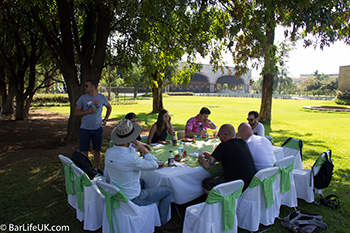
The Herradura Hacienda is 120 hectares of beautifully manicured gardens, exotic plants (more on these later) and a whole lot of tequila making equipment. There are also beautiful little houses within the protective walls for workers from the distillery to live in. Whilst the threat from bandits and thieves is significantly less these days, this was the purpose when the hacienda was originally constructed in 1826.
There is a long and rich history of the hacienda, and the tequila it produces:
1826 – Padre Feliciano builds a grand new residence on the site named Hacienda del Padre (The Priest House)
1858 – The Hacienda is passed onto Feliciano’s goddaughter Josefa Salazar, she hires Felix Lopez to manage the distillery and hacienda.
1866 – Much of the hacienda is given to Lopez as part of his employment arrangement.
1870 – Lopez takes majority ownership and renames it Hacienda San Jose del Refugio. Officially registered as a place of tequila production
1928 – Tequila Herradura registered
1963 – New distillery opened, old distillery turned into a museum. Herradura Anejo launched
1974 – Herradura Reposado launched
1994 – El Jimador launched
2007 – Company sold to Brown-Forman
In amongst all of that, the company was mainly owned at any given point by either the Lopez or Rosales (Felix Lopez wife’s family) families, plus there was a civil war resulting with the owners being on the run. This history is evident through the tour with new shiny buildings sitting seamlessly alongside buildings and plants dating back hundreds of years.
This merging of the old and the new is evident in tequila distilleries everywhere you go, it is part of the charm of not only the distilleries but of Tequila Town itself. They are proud of their heritage, love the old stories, respect those that have the experience and knowledge many years in the business brings, but at the same time embrace new technologies and ideas.
It is this combination that enables them to produce such great tequila. Whilst the recipes may not have changed, new equipment and technology has, where it improves the product, been embraced. Some companies and brands embrace it more than others, which we will touch on, but they are not shy to admit when they do… well most of them.
Anyway back to the job in hand. Tequila. Herradura.
Rather handily the Casa Herradura tour follows the production journey so we will take you on that tour, looking at tequila production in general and specifically what Herradura does. Our guide on this adventure was Ruben Aceves Vidrio, having been at Herradura for 16 years he is, simply put, the man. He also has a family connection to the brand as his Grandmother used to part own the distillery before selling her shares to her sisters.
Agave
Even the most tequila-shy bartender in the world will know that tequila is made from agave, the blue agave to be precise. Legend has it that it was discovered that these spiky, vicious looking plants produced sweet tasting liquid when heated after a lightning bolt hit one back in ancient times. It’s a lovely story, complete rubbish, but lovely.

Herradura have 11,000 hectares (over 27,000 acres) of agave fields with the largest field (known as a potreros) covering 15 hectares. Depending on the distillery the agaves are either brought in from independent agave farmers or produced on distillery owned fields, often a combination of the two. In Herradurra’s case the 200 tonnes of agave they have delivered every day comes from their own fields only.
Not only does this give them a better hold on quality, but allows them to keep a better handle on the pricing. Agave has, at various times, been through some big shortages due to either disease or adverse weather conditions. This not only drives the price up but also leads to a big increase in agave theft, a major issue to producers. When it takes 7 – 9 years for the plant to reach maturity there is no quick fix if your crops are stolen.
At the hacienda, Herradura have some agave plants growing to give visitors a look at how they are laid out in the fields. For many in our group it was the first time they had visited a tequila distillery and a definite bucket list moment is the opportunity to harvest your own agave plant.
Up stepped Felix, a 20 year jimador (agave farmer/harvester) veteran to show us how it was done. Dressed in an impressive white outfit with cowboy hat and boots, you could be forgiven for thinking he was all style and no substance. After 20 seconds of him wielding the coa that was all forgotten.
The coa is the tool of choice for the jimador. Basically a rounded metal head on top of a long broom handle. Its effectiveness comes from the toe curling sharpness it is kept at and the skill of the wielder. It is also a tool very close to a jimador’s heart, as was obvious with the dirty looks a couple of the group got when Felix felt his pride and joy had been misused.
In no time at all the agave plant had been harvested, which consists of it being dug out of the ground, the sharp leaves being removed and the bitter leaf ends being taken from the heart of the plant, known as the pina, before being cut in half. Felix stepped back and invited others to try.
Thomas Soden was arguably the fittest member of the group and without doubt was the most aptly dressed – cowboy hat, boots and even a snakeskin belt adorning his jimador effort. It took approximately 5 seconds before anyone walking past would have figured out a jimador he was not. Grunts, staggering and general confusion were all on display.
It was only when several other members of the group had given it a go that Tom’s efforts could be appreciated for their speed. Peter Skelton sweated out more liquid than a pina can hold (one pina produces 7 – 10 bottles of tequila on average) and Eoin Kenny managed to cut himself, although he claimed ‘that’s how gingers sweat’.
The quality of the agave is not just in the plant itself but in the preparation skill of the jimador, any bitter elements left on the pina will find their way into the tequila.
Cooking
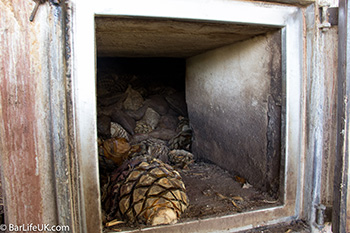
As we had enjoyed breakfast earlier in the day we had been overlooking the big building containing the ovens Herradura use. Outside the ovens was a gigantic pile of pinas. Now we stood next to them we couldn’t help but wonder how long it would have taken our group to harvest the hundreds that sat before us. Best guess was about a week, with at least two of us missing toes.
There are two methods used for cooking the agave, the traditional clay/brick oven method (known as hornos) and the newer ‘autoclave’ method. The argument for and against these is long debated by both sides with each putting across their argument like this:
Hornos – takes longer but produces a better quality juice
Autoclave – More effective and time efficient, doesn’t really alter the quality of the tequila too much
As it goes they both have their advantages and it is an argument that will continue for many years and decades to come. From our point of view we tend to prefer the flavour of tequilas made in hornos. There are obviously lots of other factors at play but it seems to be an element that holds true.
Anyway back to Herradura. Each of their hornos are stacked, flat side down, with 40 tonnes of pinas which have been cut in half (and bags full of the little bits of the plants which fall off in production). This stacking method allows the weight of the agave to squeeze the juice out of the agaves at the bottom, which cook quicker.
The ovens are steam heated for 26 hours at 95 degrees celsius before being allowed to cool for a further 24 hours. The ovens are then drained of all that lovely juice and the agaves removed and put through a milling process.
Whilst it is true that if you were following the old methods you would have a donkey pulling a big stone wheel called a tahona to crush the agave, it is also true that not all the old methods are better. I challenge anyone, no matter how expert they are, to be able to pick out the tequila made with a tahona than one without. It is simply not as effective as a modern milling machine.
Fear not though, the donkeys are still loved and we had one following us with a mini barrel of tequila on his back. We loved him at least.
One of the great things about the Herradura tour was the fact that we got to get involved in the process and taste as we went, so we could really see what the different processes give the finished product. At this point we not only got to taste cooked agave, it is difficult to describe this sweet chewy loveliness but the closest I can get is fresh honeycomb straight from the hive as opposed to mass produced honey.
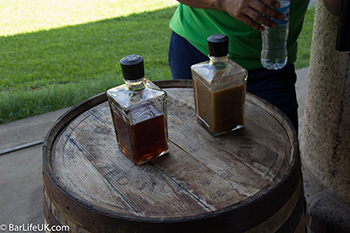
We also got to sample the two liquids produced. The juice straight from the oven was thick, sweet and full of agave flavour, almost to the point of overwhelming the taste buds. The milled liquid is 80% water, used in the milling process to extract as much juice as possible, and therefore a lot milder but, not like adding water to a whisky, this did allow some of the subtler flavours to come through.
It is these two liquids that are combined together to produce the liquid that is then moved onto the next process.
Fermentation
Fermentation is the bar back of tequila production. Over looked, under loved, but vital in the overall experience. In fact it produces, according to Ruben, 80% of the taste of the Blanco.
Fermentation is simply the process used to convert all the natural sugars into alcohol. To do this you need agave juice, water and, the magic ingredient, yeast. It is the yeast involved that sees Herradura stand out on its own.
Walking around the Herradura grounds from building to building is a joy for anyone with a passing interest in nature. The sun is beating down and the beautifully manicured lawns and plants are home to local birds, insects and probably snakes (but we avoided them). You can’t help but notice all of the different types of fruit trees. They all look so inviting but at no point were we offered any. They were such gracious hosts all day that this had seemed unusually mean. As always though there was a reason.
It turns out there are 16 different types of fruit trees in the Casa which have produced 300 different classified strains of yeast to float around in the air. These are encouraged by the fruit being allowed to naturally fall off the trees and rot on the floor, it would seem a waste if it wasn’t for the end result.
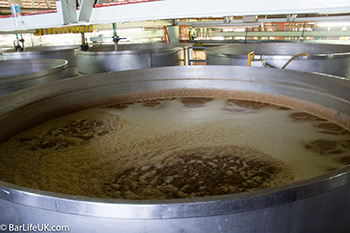
Herradura have a strong claim to being the only distillery to use 100% natural yeast and we haven’t been able to find anything concrete to refute this (although we don’t want to open criticism on this topic!). Most, if not all, other tequila distilleries use either their own propriety strains or commercially available yeasts. When you consider how much flavour comes from this process you can understand what a difference these natural yeasts can make to the finished product.
One of the problems with natural airborne yeast is it slows the rate fermentation down, resulting in Herradura’s fermentation process taking anywhere from 72 hours to a week depending on the time of the year. To put that into context a lot of other tequila producers take 24 hours to ferment. You are probably beginning to understand by now that Casa Herradura is not a place to rush.
This is a good point to quickly explain the difference here between Mixto and 100% Agave Tequila as this is the first point where the production process really changes.
Before the fermentation starts, Mixto tequila is combined with up to 49% cane or corn sugars to aid the fermentation, and reduce production costs. The agave used to make up at least 51% must still be Weber Blue Agave and the sugar element must not come from any other tequila plants.
Mixto is also allowed to add caramel colouring, oak extract, glycerin and sugar-based syrup. All of these are designed to make the final product look and taste like better tequila without all of that pesky ageing getting in the way (although mixto tequilas can be aged). Not all mixto are terrible but it’s safe to say that almost every poor reflection of tequila has involved Mixto, and/or irresponsible drinking.
Back at Herradura we were allowed to taste the fermenting ‘beer’ at the various stages from the huge stainless steel open air tanks (the largest sitting at 64,000 litres), dipping little tasting cups into the bubbling cauldrons via little bits of string. It leaves the fermentation tanks at approximately 5% ABV and is pumped through a series of pipes to its penultimate process.
Distilling
Distilling is where, at least as far as the tasting element, a distillery tour gets really fun. With the treatment we had been getting there was no doubt this was going to be an enjoyable half an hour or so.
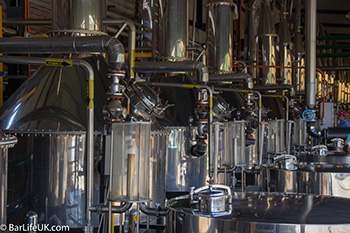
Herradura use 2,600 litre pot stills, 47 of them to be precise, all copper lined to produce their tequilas. As always we were amazed by the sparkling cleanliness of such industrial machines, the same level of care seems to be taken on their outsides as is put into the liquid on the insides.
All tequila must, by law, be distilled twice. In Herradura’s case this results in a 3 hour first distillation and a 6 hour second distillation. Herradura also takes the unusual step of cutting the heads and tails during both distillations, approximately 12% of the liquid each time.
Not ones for waste at Herradura, that heads and tails liquid is sent off to their onsite water treatment plant where it is used to produce energy for the distillery. In fact, 13% of the energy needed to run the pot stills comes from the plant.
There are three liquids in the distilling process and once again we were privy to trying them all:
Mosto Muerto – This is the name given to the product pumped from the fermentation tanks before it is distilled for the first time. About 5% ABV it is, for anyone that has tried one, a bit like a sour beer.
Ordinario – Following the first distillation a product comes off the still at around 25% ABV. At this point the ‘tequila’ notes are beginning to come through but there is still a slight hint of the sour beer. It is certainly not horrible.
Tequila – The real deal. Coming off at 55% this is tequila in its purest form. Un-aged and not cut with water, this is what the distillers pride themselves on.
In Mexico Herradura have a product called Directo de Alambique which is this liquid straight from the still. It is Ruben’s favourite tipple and quickly became the group’s as well and is now available in the UK.
As we said the distillery is now state-of-the-art, even if it does use some older techniques, however it wasn’t always so shiny. As recently as 1963 Herradura used the old distillery to produce their products and it is still there, preserved as a museum to show the old methods to interested tourists and bartenders.
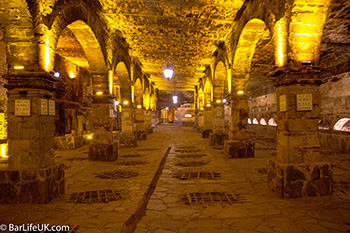
A big brick building, it is a hugely impressive structure where you really get a feel for what it must have been like when it was pumping out tequila. The first thing you see is the big tahona wheel (cue obligatory picture opportunity of people trying to push it), the size of which is pretty daunting. Moving into a huge cavernous room with dozens of pits in the floor where the juice was fermented (cue obligatory people in fermenting tank picture opportunity) then to the stills which were working non-stop to keep up with production, and the pits beneath them which had to be loaded by hand to keep the heat up.
You immediately see how much more labour intensive the processes must have been back in the day and how much harder it would have been to keep the consistency in the product. There is a rumour that they might try to produce a special tequila using the old distillery and the old methods. We really are hoping they pull this off and we are offering free services if they need any highly untrained staff to help out.
The same year that they moved to the new facility, 1962, they introduced their first aged tequila, which takes us rather smoothly onto the final piece in the tequila puzzle.
Ageing
Up until 2007 Herradura was a family owned business, the decision was then made to sell it to Brown-Forman for rather a lot of money (my mum always said it was rude to talk about money, so let’s just say there were a few zeros involved).
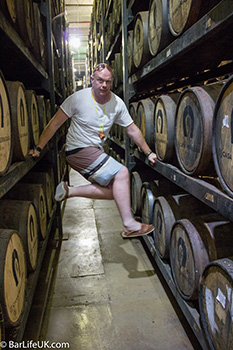
There were many advantages with this buy-out (besides the cash) not least the fact that Brown- Forman have their own cooperage which spends a lot of time making the vast quantities of Jack Daniels barrels it needs. This means that they are now able to get barrels directly from there with their own charring needs catered for.
As explained to us, there are 5 types of tequila, and ageing is often the difference between them:
Blanco (also known as Plata, Silver or White) – Does not have to be aged at all. However, Herradura do age their Plata for 45 days to give it a smoother finish (the Directo Alambique as stated earlier is not aged).
Gold – Is not a form produced by Herradura, and is usually made with mixto tequila but can be made with 100% agave tequila. Gold is the expression that is made when the colour comes from the addition of caramel or other flavourings/colourings but can also come from blanco being mixed with aged tequila – as mentioned, definitely not practiced at Herradura.
Reposado – A straight translation means ‘rested’. Must be aged for between 2 – 12 months.
Anejo – Must be aged for a minimum of 1 year in barrels that do not exceed 600 litres.
Extra Anejo – Must be aged for a minimum of 3 years in barrels that do not exceed 600 litres.
Herradura had one more trick up their sleeve for us. Their aged tequilas go into giant aeration tanks for 70 hours before they are bottled. This was explained to us at the Casa as the equivalent of taking a nice bottle of red wine and decanting it. This allows the more volatile undesirable compounds to evaporate, whilst the more desirable aromatic and flavourful ones remain.
This was certainly a first for us and although there may be others now doing it (if there are, we haven’t visited them yet) Herradura were certainly the first in the world of tequila.
All that remains is for the tequila to be bottled, which Herradura also do on site, and there you have it.
As mentioned at the start, this was the best distillery tour I have ever done and I fear that I have not done the experience justice. Hopefully what I have managed to convey is not only the hands- on element of the tour, but also the opportunity to truly understand that spirit by tasting every element of the process. It should also be pointed out that a write up like this would not be possible without the honest and open answers Ruben gave to every question put to him.
A massive thank you to Ruben and his team as well as the UK Brown-Forman and Mangrove teams for making it such a memorable day and trip. Do whatever you can to get on this trip, sell a Grandma, tickle a gibbon, or probably more likely, win a competition or sell a shed load of Herradura.
There is one more surprise coming from this trip in the form of the first bar from the UK to choose their very own barrel for exclusive bottling. We will be bringing you news of what happened when they chose their tequila and the process they went through when it lands in the UK in September.


